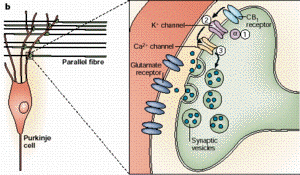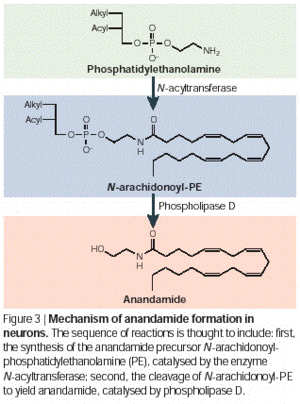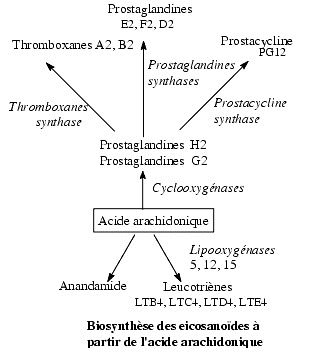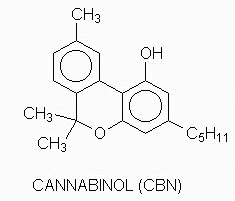- The endocannabinoids are a family of lipid
messengers that engage the cell surface
receptors that are targeted by
Æ9-tetrahydrocannabinol, the active principle in
marijuana (Cannabis). They are made on demand
through cleavage of membrane precursors and are
involved in various short-range signalling
processes. In the brain, they combine with CB1
cannabinoid receptors on axon terminals to
regulate ion channel activity and
neurotransmitter release. Their ability to
modulate synaptic efficacy has a wide range of
functional consequences and provides unique
therapeutic possibilities.
-
-
- The Cannabis plant has been used in Europe
since antiquity, mostly to make cordage and
fabric, but first attracted the attention of
European scientists when Napoleon's troops
brought back from Egypt intriguing accounts of
its psychotropic activity. In 1810, a member of
Napoleon's Commission des Sciences et des Arts
wrote:
-
- "For the Egyptians, hemp is the plant par
excellence, not for the uses they make of it in
Europe and many other countries, but for its
peculiar effects. The hemp cultivated in Egypt
is indeed intoxicating and narcotic."
-
- Before long, detailed descriptions of the
plant's properties began to appear and Cannabis
extracts were introduced to the medical
community.An 1848 commentary of the British
Pharmacopoeia outlined quite accurately the
psychotropic effects of Cannabis and pointed out
its merit as an analgesic and
antispasmodic:
-
- "Numerous observers have described the
Indian hemp as producing in the natives of the
East, who familiarly use it instead of
intoxicating spirits, sometimes a heavy, lazy
state of agreeable reverie, from which the
individual may be easily roused to discharge any
simple duty sometimes a cheerful, active state
of inebriation causing him to dance, sing and
laugh, provoking the venereal appetite, and
increasing the desire for food and sometimes a
quarrelsome drunkenness, leading to acts of
violence.During this condition pain is assuaged
and spasm arrested. […] On the
whole, it is a remedy which deserves a more
extensive inquiry than any hitherto
instituted."
 - The inquiry into the active chemical
constituents of Cannabis turned out to be more
time consuming than expected.Many other
plant-derived compounds, such as morphine and
atropine, had long been identified when the
Cannabis plant finally yielded its active
principle, the terpenoid derivative
Æ9-tetrahydrocannabinol THC). The psychoactive
properties of THC were recognized immediately,
but the drug's unique chemical structure offered
no hints as to its mechanism of action.
-
- To complicate matters further, the
hydrophobic nature of THC delayed
experimentation and indicated that the compound
might act by influencing membrane fluidity,
rather than by combining with a specific
receptor. This impasse was resolved by the
development of new classes of potent and
selective THC analogue,which led eventually to
the pharmacological identification of
cannabinoid-sensitive sites in the brain. The
CB1 cannabinoid receptor was molecularly cloned
from rat brain in 1990 and its immunesystem
counterpart, the CB2 receptor,was identified by
sequence homology three years later.These
discoveries not only established the mechanism
of action of THC, thereby fuelling the
development of subtype-selective agonists and
antagonists, but they also initiated a hunt for
brain-derived cannabinoid ligands. Surprisingly,
the first THC-like factor to be isolated was a
lipid, rather than the peptide that had been
expected on the basis of the precedent set by
morphine and the enkephalins.
-
- It was identified as the amide of
ARACHIDONIC ACID with ethanolamine, and named
anandamide after the Sanskrit word for bliss,
ananda. This small lipid molecule resembled no
known neurotransmitter, but it did share
structural features with the
EICOSANOIDS,mediators of inflammation and pain
with various functions in neural
communication12.
-
- Though initially controversial, the
signalling roles of anandamide were confirmed by
the elucidation of the compound's unique
metabolic pathways and the demonstration of its
release in the live brain14Ð16.As the search
for THC-like compounds continued, other
bioactive lipids were extracted from animal
tissues. These include 2-arachidonoylglycerol
(2-AG) noladin ether, virodhamine and
N-arachidonoyldopamine.
-
- In this article, I review the synthesis,
release and deactivation of the endogenous
cannabinoids (also called endocannabinoids). I
then outline the properties and distribution of
brain CB1 receptors. Last, I describe the
function of the endocannabinoids as local
modulators of synaptic activity and their
contribution to memory, anxiety,movement and
pain.
 -
-

- voir
site pharmacorama

|






